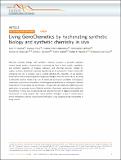Files in this item
Living GenoChemetics by hyphenating synthetic biology and synthetic chemistry in vivo
Item metadata
| dc.contributor.author | Sharma, Sunil V. | |
| dc.contributor.author | Tong, Xiaoxue | |
| dc.contributor.author | Pubill-Ulldemolins, Cristina | |
| dc.contributor.author | Cartmell, Christopher | |
| dc.contributor.author | Bogosyan, Emma J. A. | |
| dc.contributor.author | Rackham, Emma J. | |
| dc.contributor.author | Marelli, Enrico | |
| dc.contributor.author | Hamed, Refaat B. | |
| dc.contributor.author | Goss, Rebecca J.M. | |
| dc.date.accessioned | 2017-08-21T10:30:06Z | |
| dc.date.available | 2017-08-21T10:30:06Z | |
| dc.date.issued | 2017-08-09 | |
| dc.identifier | 250890459 | |
| dc.identifier | cbc03331-4d47-4811-912a-3cfd1b26bded | |
| dc.identifier | 85027232303 | |
| dc.identifier | 000407198800018 | |
| dc.identifier.citation | Sharma , S V , Tong , X , Pubill-Ulldemolins , C , Cartmell , C , Bogosyan , E J A , Rackham , E J , Marelli , E , Hamed , R B & Goss , R J M 2017 , ' Living GenoChemetics by hyphenating synthetic biology and synthetic chemistry in vivo ' , Nature Communications , vol. 8 , 229 . https://doi.org/10.1038/s41467-017-00194-3 | en |
| dc.identifier.issn | 2041-1723 | |
| dc.identifier.uri | https://hdl.handle.net/10023/11518 | |
| dc.description | We thank the European Research Council under the European Union’s Seventh Framework Programme (FP7/2007–2013/ERC consolidator grant GCGXC grant agreement no 614779) and ERAIB (Grant no. 031A338A) and H2020-MSCA-IF-2014 Grant no. 659399 for generous financial support. | en |
| dc.description.abstract | Marrying synthetic biology with synthetic chemistry provides a powerful approach toward natural product diversification, combining the best of both worlds: expediency and synthetic capability of biogenic pathways and chemical diversity enabled by organic synthesis. Biosynthetic pathway engineering can be employed to insert a chemically orthogonal tag into a complex natural scaffold affording the possibility of site-selective modification without employing protecting group strategies. Here we show that, by installing a sufficiently reactive handle (e.g., a C-Br bond) and developing compatible mild aqueous chemistries, synchronous biosynthesis of the tagged metabolite and its subsequent chemical modification in living culture can be achieved. This approach can potentially enable many new applications: for example, assay of directed evolution of enzymes catalyzing halo-metabolite biosynthesis in living cells or generating and following the fate of tagged metabolites and biomolecules in living systems. We report synthetic biological access to new-to-nature bromo-metabolites and the concomitant biorthogonal cross-coupling of halo-metabolites in living cultures. | |
| dc.format.extent | 10 | |
| dc.format.extent | 1183453 | |
| dc.language.iso | eng | |
| dc.relation.ispartof | Nature Communications | en |
| dc.subject | QD Chemistry | en |
| dc.subject | QH301 Biology | en |
| dc.subject | Chemistry(all) | en |
| dc.subject | Biochemistry, Genetics and Molecular Biology(all) | en |
| dc.subject | Physics and Astronomy(all) | en |
| dc.subject | NDAS | en |
| dc.subject | BDC | en |
| dc.subject | R2C | en |
| dc.subject.lcc | QD | en |
| dc.subject.lcc | QH301 | en |
| dc.title | Living GenoChemetics by hyphenating synthetic biology and synthetic chemistry in vivo | en |
| dc.type | Journal article | en |
| dc.contributor.sponsor | European Research Council | en |
| dc.contributor.sponsor | BBSRC | en |
| dc.contributor.institution | University of St Andrews. School of Chemistry | en |
| dc.contributor.institution | University of St Andrews. Biomedical Sciences Research Complex | en |
| dc.contributor.institution | University of St Andrews. EaSTCHEM | en |
| dc.identifier.doi | 10.1038/s41467-017-00194-3 | |
| dc.description.status | Peer reviewed | en |
| dc.identifier.grantnumber | GCGXC | en |
| dc.identifier.grantnumber | BB/M004570/1 | en |
This item appears in the following Collection(s)
Items in the St Andrews Research Repository are protected by copyright, with all rights reserved, unless otherwise indicated.

